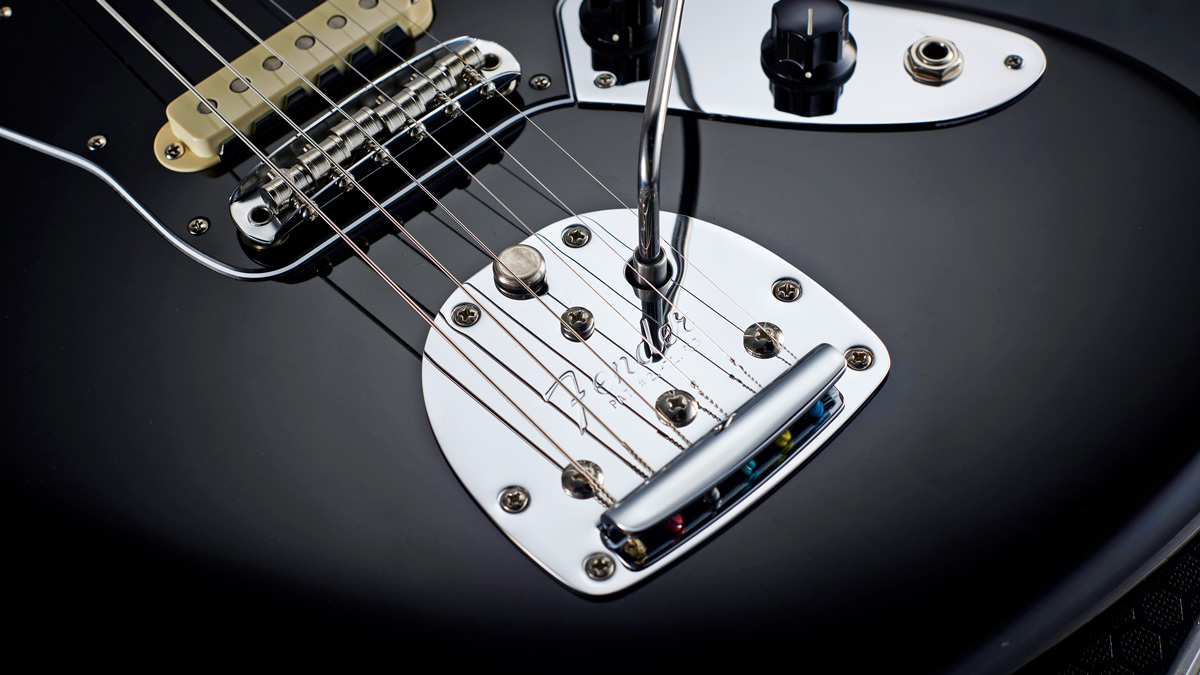MusicRadar Verdict
This guitar has lots to offer, even if you're not a fan of Marr. If that's the case, you can always do what Marr himself does and remove his signature from the headstock!
Pros
- +
Superb re-working of the Jaguar; instant 'indie' sounds with all the niggles of the Jag sorted.
Cons
- -
Even with the tweaks, it's still a 'Marmite' guitar!
MusicRadar's got your back

Fender Johnny Marr Jaguar

Fender Johnny Marr Jaguar
Johnny Marr's new Fender Jaguar doesn't replicate a specific model, but it does incorporate all of his suggested tweaks and is exactly the guitar he plays himself (although he does remove his signature on the headstock and have the metal parts aged).
Fender had made him one in this black finish - a classic 'rockers' vibe - and thought it was a perfect addition to the other colours on offer. It's also the best-selling Jaguar in the line, Fender tells us.
As we reported on its launch back in 2012 , the numerous tweaks were executed by a small team in the UK: Brit repair guru Bill Puplett, engineering whizz John Moore, and Tim Mills at Bare Knuckle, who set about 'unravelling' the Jag's idiosyncrasies to improve the 'ugly ducking', but still keep the vibe of Fender's most leftfield solidbody.
So, while the scale and fingerboard radius remain old-school, and the neck profile is modelled on one of Marr's own Jags from 1965, the bridge saddles are swapped to solid non-height adjustable Mustang saddles that sit flush on the bridge tray and create a wider string spacing - which does mean that the outer strings get closer to the fingerboard edge the further up the 'board you go.
The bridge pivots in the same fashion, but nylon 'locks' prevent the needle-point pivot screws from moving under tension, plus there's a nylon insert to the vibrato arm collar; it still push-fits, but it feels smoother and less 'floppy' in use.
The Marr neck has a Marmite feel, which is deep front to back with a rounded, D-like steeper shoulder feel.
Another big change is swapping from the Jaguar's dual rhythm/lead concept. Here, we have just a single circuit with a four-way Tele-style switch that offers bridge, bridge and neck (in parallel), neck, and in position four, neck and bridge in series.
Additionally, there are two low-profile slider switches for high-pass filters. The top switch is the master filter, while the lower switch is mounted at a right angle and only works on the series linkage, position 4 on the pickup selector.
Feel & Sounds
The Marr neck has a Marmite feel, which is deep front to back with a rounded, D-like steeper shoulder feel.Marr has 0.010 to 0.046 supplied setup (it also comes with an 0.011 to 0.050 flatwound set in the case, for the brave among us).
You'd think that the short scale of Marr's model would balance out the feel, but the action feels higher here and there's a subtly short, plinky response. This is probably created by the long 'unused' string length from the bridge to the vibrato, which creates the perception of a stiffer feel.
The Marr couldn't be more different to the recently-reviewed Edge Strat. Yes, of course, it centres on classic Fender single coil, so it's not the first choice for jazz (not that this stopped a certain Joe Pass), but whether it's the less sustaining voice or, indeed, the whole package, it sounds older and less modern on the one hand, though not in a gurning blues fashion.
It's edgier, not least with those high- pass filters - a very 'rhythm guitar' that Marr proves can serve almost as a blank canvas for quite effected tones. Even so, that indie edge seems built in, adding attitude in spades. If that's not your bag, you might be better off with The Edge's more mainstream squeeze, but the Marr Jag is a great choice for the leftfield.
The success of a signature model - aside from the fans of said artist - is a broad appeal. Marr's Jaguar is exactly that: a niche guitar expanded without losing its DNA.
Dave Burrluck is one of the world’s most experienced guitar journalists, who started writing back in the '80s for International Musician and Recording World, co-founded The Guitar Magazine and has been the Gear Reviews Editor of Guitarist magazine for the past two decades. Along the way, Dave has been the sole author of The PRS Guitar Book and The Player's Guide to Guitar Maintenance as well as contributing to numerous other books on the electric guitar. Dave is an active gigging and recording musician and still finds time to make, repair and mod guitars, not least for Guitarist’s The Mod Squad.
“Every note counts and fits perfectly”: Kirk Hammett names his best Metallica solo – and no, it’s not One or Master Of Puppets
Ranked: Bon Iver's albums, from Sable, Fable to For Emma, Forever Ago
“Its mission is simple: unleash the power of any amplifier or line-level source without compromise”: Two Notes promises a “watershed” in tube amp control with the Torpedo Reload II










